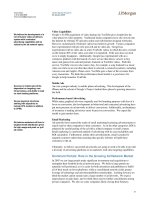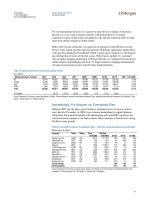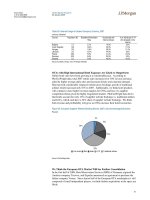Net plus SG
Bạn đang xem bản rút gọn của tài liệu. Xem và tải ngay bản đầy đủ của tài liệu tại đây (149.51 KB, 6 trang )
Characteristics of Ethernet Standards
Scope
•
Define 10 Mbps Ethernet, Fast Ethernet, and Gigabit Ethernet.
•
Identify the different types of Ethernet in terms of speed, length, topology, and cable type.
Focused Explanation
Ethernet has more variants than any other type of LAN today.
10 Mbps Ethernet
The original Ethernet system operated at 10 Mbps based on the 10Base5 and 10Base2 specification. A
series of coaxial cables were used to connect each device in place of switches, hubs, or wiring panels.
The series of cables created an electrical bus that was shared among all devices on the Ethernet.
In a single bus, only one electrical signal flows at any given time as per the original Ethernet specification,
which supports half duplex behavior where one sender is on the network. This led to increased latency
periods. Even the introduction of CSMA/CD did not reduce the latency period. To overcome this problem,
LAN switches were introduced. LAN switches had only one device cabled to them, and this allowed fullduplex operation. This solutions overcame problems created by collisions and CSMA/CD. Because no
collisions are possible, full-duplex operation reduces Ethernet congestion.
The advantages of full-duplex operation in comparison to half-duplex 10BaseT operation includes no
latency period before sending the frames, no collisions, and doubling of the available bandwidth of 10
Mbps capacity in each direction.
The specifications for the four main 10 Mbps Ethernet standards are shown in Table 1.2 at the end of this
section.
Fast Ethernet
Many familiar features of 10 Mbps Ethernet such as CSMA/CD, a variety of cabling options, and
deployment of shared hubs and switches are retained in Fast Ethernet variants. Fast Ethernet gained
market acceptance around the same time that LAN switching became popular. Most Fast Ethernet cards
are connected to a switch or cabled to another device.
The two key features of Fast Ethernet, as compared to 10-Mbps Ethernet, are higher bandwidth and
autonegotiation. Autonegotiation allows an Ethernet card or switch to operate at 10 or 100 Mbps. It also
negotiates half-duplex or full-duplex operation. If the other device is not able to autonegotiate, it settles for
half-duplex operation at 10 Mbps.
Note: Slow devices should be user-configured to a desired setting rather than allowed to depend on
autonegotiation. Ports that are used for end-user devices enable autonegotiation because these devices
are moved frequently relative to servers or other network devices, such as routers.
Gigabit Ethernet
Gigabit Ethernet is built on top of the Ethernet protocol, and it increases speed tenfold to 1000 Mbps, or 1
gigabit per second (Gbps). This specification promises to be a prominent player in high-speed LAN
backbones and server connections. Several changes have been made to the physical interface to
enhance speeds from 100 Mbps Fast Ethernet up to 1 Gbps. This has been done by merging IEEE 802.3
Ethernet and ANSI X3T11 Fiber Channel.
Media Connectors, Media Types, and their Uses
Scope
•
Identify different types of media connectors, such as RJ-11/RJ-45, MT-RJ, ST/SC, IEEE 1394, Fiber,
LC F-Type, and USB, and describe their uses.
•
Identify the different types of media, such as Category 3, 5, 5e, and 6 media types, coaxial cables,
twisted pair cables, and optic cables, and describe their uses.
Focused Explanation
Media Connectors
RJ-11 (Registered Jack-11): RJ-11 is a four or six wire connection. It is a standard telephone cable or a
computer modem connector in the USA.
RJ-45 (Registered Jack-45): RJ-45 is similar to the RJ-11 telephone cable connector, but is larger and
accommodates 8 wires. It is commonly used for 10BaseT and 100BaseTX Ethernet connections. RJ-45 is
used on all types of twisted pair cable, including Category 3, 4, and 5 UTP.
The varied uses of RJ-45 are as follows:
•
Use of four wires of an RJ-45 plug in an Ethernet (10BaseT) and Token Ring network.
•
Use of all eight wires of an RJ-45 plug in 100BaseVG.
•
Use of the same four wires of the RJ-45 connector as 10BaseT in 100BaseTX. However, the wire
belongs to Category 5 instead of Category 3.
Mechanical Transfer Registered Jack: Mechanical Transfer Registered Jack (MT-RJ) is a small duplex
connector featuring two pre-polished fiber stubs. Used to connect fiber cables to hardware, this connector
resembles the RJ-45 connector. Termination is carried out by inserting the two cleaved fibers into the
connector, where they are aligned and butted up through a v-groove. Interstices are filled with index
matching gel to improve attenuation and return loss performance. An internal clamping device holds the
fibers in position.
Figure 1-6 shows the MT-RJ connector.
Figure 1-6: MT-RJ Connector
This connector type is used by both single-mode and multimode fiber optic cables.
Straight Tip / Standard Connector: The fiber network segments require two fiber cables: one for
transmitting data, and the other for receiving data. Each end of a fiber cable is fitted with a plug that can
be inserted into a network adapter, hub, or switch. The fiber optic connectors are used to align and join
two or more fibers together to provide a means for attaching to, or decoupling from, a transmitter,
receiver, or any other fiber optic equipment.
Table 1-3 shows the similarities and differences between the Straight Tip (ST) and Standard Connector
(SC) connectors.
Features
Type
Made of
Design
Easy identification
Distance and reliability
Developed by
Use
Popularity
Usage type
Advantage
SC connector
Fiber optic connector
A precision zirconium ceramic
ferrule
2.5 mm ferrule, push-pull
latching mechanism, and the
ability to be snapped together
to form duplex and multi-fiber
connectors
Jacketed fiber version with
color coded boots facilitate
fiber identification when
terminated to duplex patch
cords
Same
--
ST connector
Same
Same
Preferred fiber optic cable for
premises cabling and is
recommended by the TIA/EIA568 standard
-In North America, most cables
use a square SC connector that
slides and locks into place when
inserted into a node or
connected to another fiber
cable
It is keyed and can be
configured so that the correct
polarity is guaranteed when
mated with a patch cord
assembly
Used with Ethernet 10BaseFL and FIORL links
2.5 mm ferrule design and
bayonet connector-toadapter mating
Same
Same
AT&T
More popular
Europeans use a round ST
connector instead.
--
Table 1-3: Comparison of the ST and SC Connectors
Note: Connectors of different types can communicate with the use of adapters or couplers, but it is best
to choose one type of connector for your entire network.
IEEE 1394 (FireWire): FireWire connectors exist as 4-pin, 6-pin, and 9-pin connectors. A 6-pin FireWire
400 connector provides a maximum of 7 watts of power when the system is running. The maximum
voltage provided by this connector is 12.8 V (no load) and 7 W power per port.
FireWire 800 uses a 9-pin connector and provides nearly 12.8 V on the power pin. This pin is based on
the 1394b specification. Using the appropriate cable, this connector works effortlessly with legacy
FireWire devices.
To serve the network requirements of a home network, the 1394b specification was set. This enables
transmission beyond the 4.5-meter length originally set by 1394a. The media type under this specification
includes unshielded twisted pair CAT-5 cable; plastic optical fiber (POF); hard polymer clad fiber (HPCF)
also known as glass optical fiber (GOF); and shielded twisted pair (STP).
Fiber LC: The Fiber Local Connector (LC) is a small form factor (SFF) connector and is ideal for high
density applications. A Behind-the-Wall (BTW) version with a short connector and boot is available for
ultra compact requirements.
The LC connector has a zirconium ceramic ferrule measuring 1.25 mm in outer diameter (OD) with either
a Polished Connector (PC) or Angled Polished Connector (APC) endface, and provides optimum insertion
and return loss. It is used on small diameter mini-cordage (1.6 mm/2.0 mm) as well as 3.0 mm cable.
They are available in pre-assembled or unassembled formats. LC adapters are available in simplex and
duplex configurations and fit the standard RJ-45 panel cutout. They feature self-adjusting panel latches
and a choice of mounting orientations with labeled polarity. It is used in Gigabit Ethernet, video, active
device termination, telecommunication networks, multimedia, industry, and military. Figure 1-9 shows the
Fiber LC connector.
Figure1-9: Fiber LC Connector
F-type Connector: The F-type
connector provides
cable/satellite/HDTV/DVD video and high-speed broadband cable modem connectivity at wall plates.
Figure 1-10 shows the F-type connector.
Figure 1-10: F-Type
Connector
Universal Serial Bus (USB):
This is a computer standard designed
to eliminate the guesswork in
connecting peripherals to your PC.
The design of USB is standardized by the USB Implementers Forum (USBIF). The USB specification is at
version 2.0 as of January 2005.
USB connectors are designed to be robust. An adjacent plastic tongue protects the electrical contacts in a
USB connector, and the entire connecting assembly is further protected by an enclosing metal sheath.
Connected USB devices power themselves through a single 5-volt wire. A given segment of the bus is
specified to deliver up to 500 mA. This is more than sufficient to power several devices, although this
budget must be shared among all devices downstream in a non-powered hub. Figure 1-11 shows the
USB connectors.
Media Types
Coaxial Cable
It is an electrical cable consisting of a round, insulated conducting wire, surrounded by an insulating
spacer, followed by a cylindrical conducting sheath, and a final insulating layer. Coaxial cable is capable
of carrying a high frequency or broadband signal as a high-frequency transmission line. The surrounding
layers in the cable offer protection to the electromagnetic signals from any kind of external
electromagnetic interference.
Networking coaxial cables include Thicknet and Thinnet cables. Figure 1-12 shows the Thicknet and
Thinnet coaxial cables.
Figure 1-12:
Thinnet and
Thicknet Cable
Thinnet is thinner coaxial cable used for 10Base2 bus type Ethernet networks. This cable type is
obsolete. The cable is termed as RG-58 cable, and has a diameter of 3/16 inch, with an impedence of 50
ohm. Thinnet cables use Bayonet (BNC) connectors. To implement a LAN using Thinnet, BNC-T
connectors are used at each computer. The network bus must also be terminated at each end with BNC
style terminators.
Thicknet cable (now obsolete) was used in the oldest bus type Ethernet networks, which were called
10Base5 networks. This cable is also obsolete. The cable is 3/8 inch in diameter with an impedence of 50
ohm. Thicknet can carry signals up to 500 m, and uses AUI (Attachment Unit Interface) connectors.
Twisted Pair (UTP, STP)
In a twisted pair, two conductors are wound around each other to cancel out electromagnetic interference
or crosstalk. The greater the number of twists, the more the crosstalk is reduced.
Unshielded Twisted Pair (UTP) is not surrounded by any shielding and is commonly used in telephone
lines and computer networking. Shielded Twisted Pair (STP) has an outer conductive braid similar to
coaxial cables and offers the best protection from interference. It is commonly used in Token ring
networks.
Category 3 Cable: This media type is commonly used for voice and data transmission up to 16 MHz
frequencies. It supports up to 10 Mbps for Ethernet. It consists of eight copper-core wires, twisted into
four pairs with three twists per foot. Category 3 cable is used in ISDN, 10Base-T Ethernet, 4 Mbps Token
Ring, and 100VG-AnyLAN networks and in POTS since 1993.
Category 5 Cable: This media type handles up to 100 MHz frequencies. It is like Category 3 cable except
it has eight twists per foot and can be used up to 100 meters. Category 5 cable is used in most Ethernet
networks and other networks, including FDDI, and ATM at 155 Mbps.
Category 5e Cable: This media type, created in 1998, supports Gigabit Ethernet or 1-Gbps networks. It is
tested to a frequency of 200 MHz. Testing is more stringent with Cat 5e than with Cat 5 and includes
additional measurements, several of which help to improve the cable’s noise characteristics. It is used in
Ethernet networks, including Gigabit Ethernet and other networks, including 155 Mbps ATM.
Category 6 Cable / ISO Class E: This media type supports Gigabit Ethernet. It is tested to a frequency of
up to 250 MHz. This specification provides vast improvements over Category 5e, particularly in the area
of performance and immunity from external noise. It provides backward compatibility to Category 3, 5,
and 5e standards.
Optic Cables
Single Mode Fiber (SMF) cable uses a fiber that has a single core to transmit data, meaning only one
signal can be sent or received at a time. It has very small core diameter (approximately 5 to 10 microns),
and it uses laser-emitting diodes to create signals. Signal transmission is allowed at a very high
bandwidth and along very long transmission distances. Signals can transmit approximately 30 miles
before distortion occurs.
Multimode Fiber (MMF) cable has a fiber that allows multiple signals to be simultaneously transmitted and
received. It has a larger core diameter (50, 62.5, or 100 microns) than SMF, and it permits the use of
inexpensive light-emitting diode (LED) light sources. The connector alignment and coupling in MMF is
less critical in SMF. Also, the transmission distances and bandwidth of MMF are less than SMF due to
dispersion. Signals can travel approximately 3000 feet before distortion occurs.









